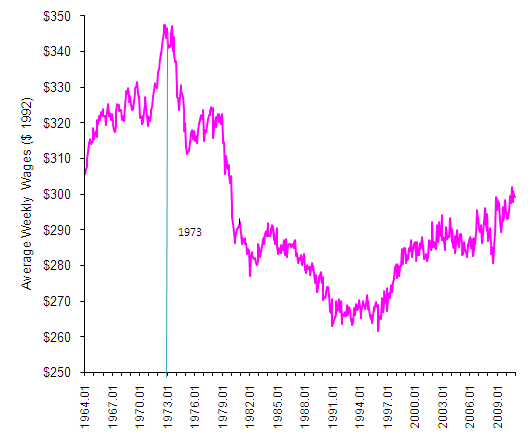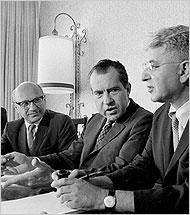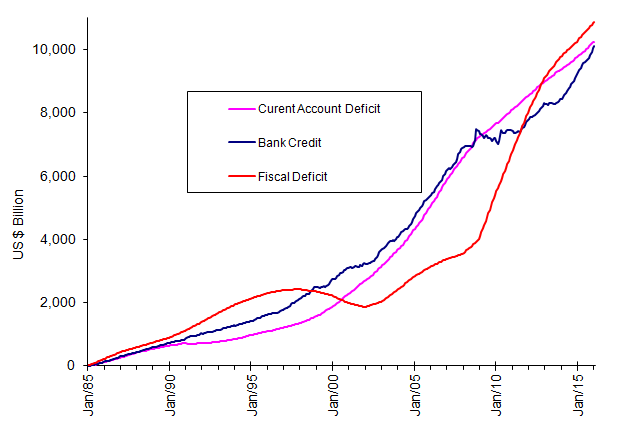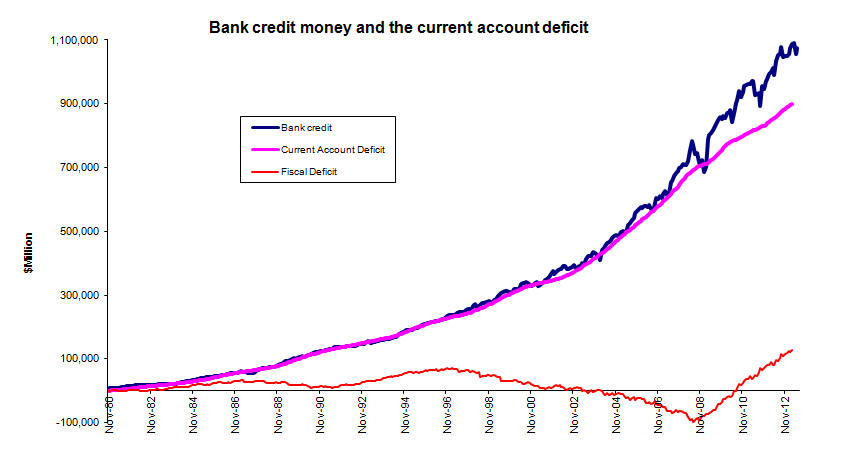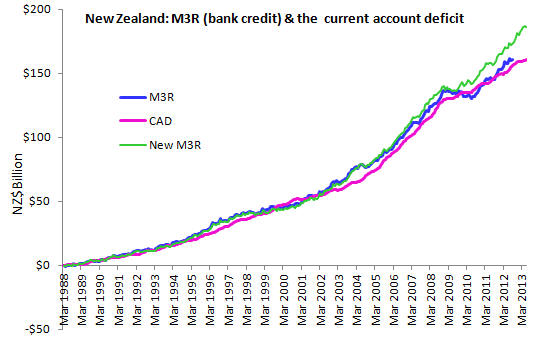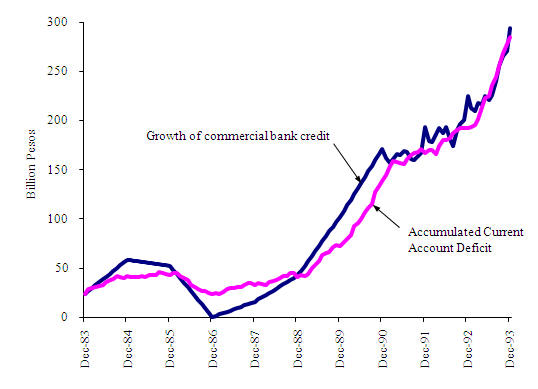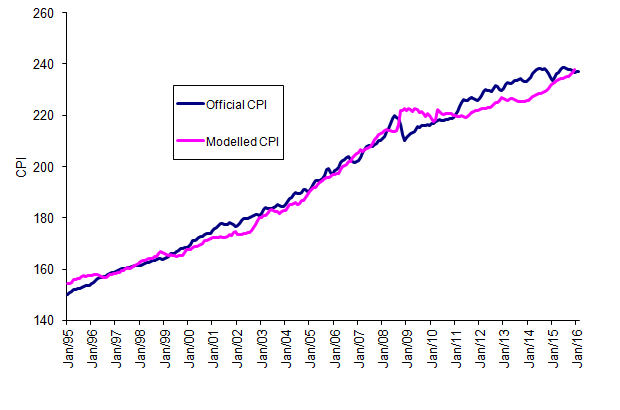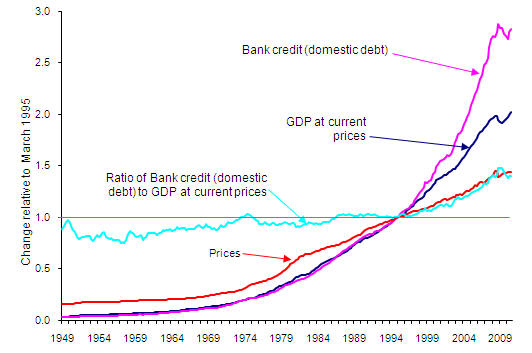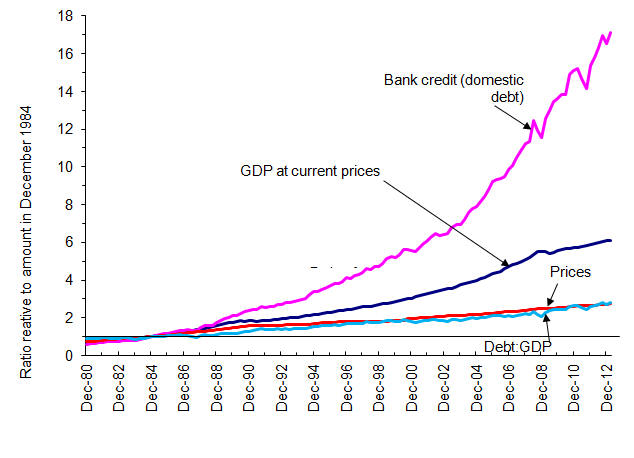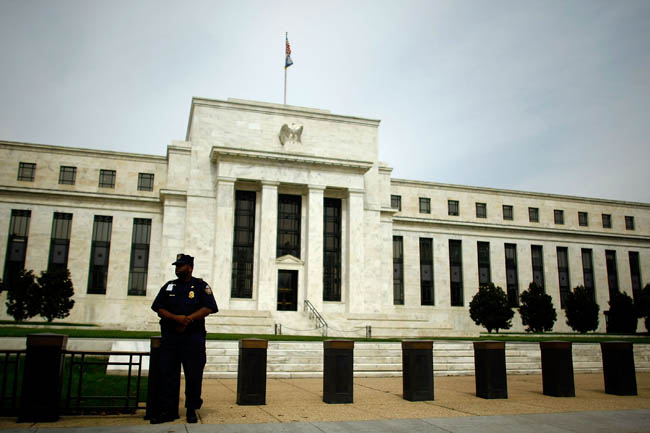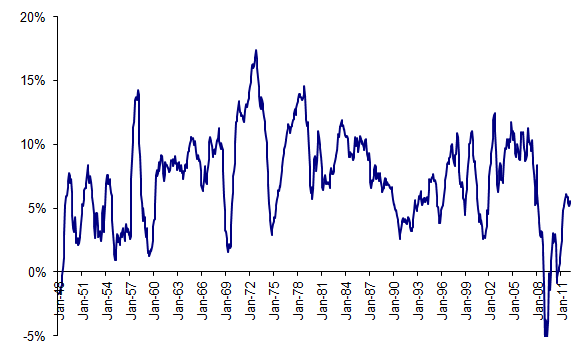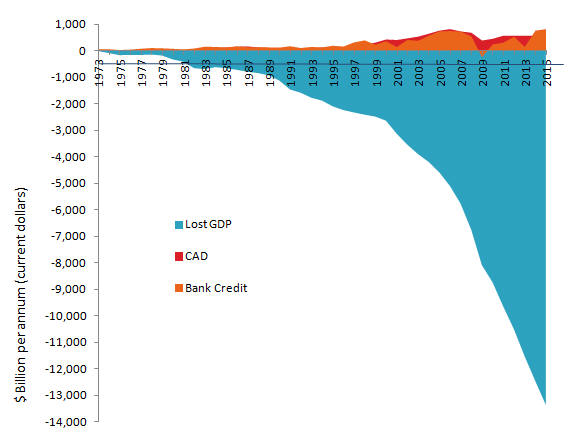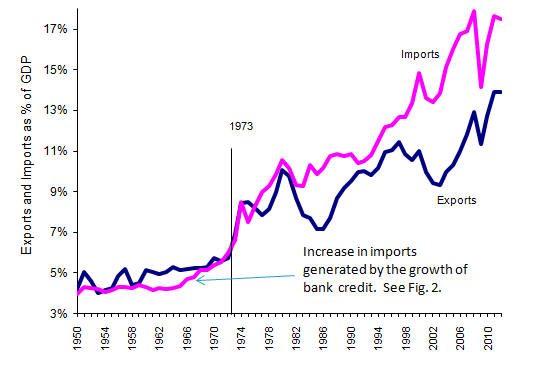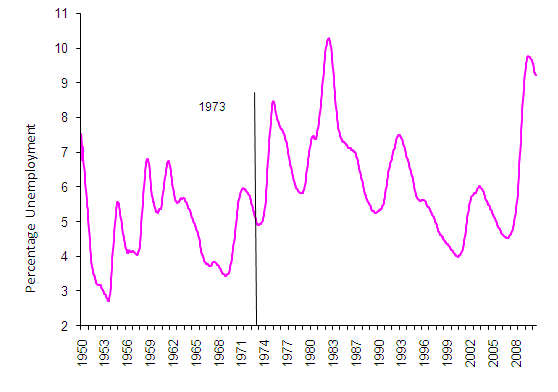|
|
Buoyant Economies Growth of Debt and Loss of Income in America |
||
|
|
Twin problems The American
financial system has two major problems. Together, they are like an
iceberg. One is is US debt which is large and
obvious. The other is the loss of income and this is enormous, costing
at least 10 times the first. Although the income problem has been
present for many years, it has never been perceived as urgent or critical;
and so it has been ignored, and is effectively unseen. The obvious problem
has been the growth of domestic and foreign debt. Over the 25 years to
2011, debts to American banks have grown at an average rate of $0.8 billion
per day. The rate of growth has been increasing. From 2000 to
2011, it had been averaging $1.6 billion per day. On the other hand,
the unseen income problem is currently costing the American economy about $23
billion per day over that period, and continues to grow. This income problem
has caused the demise of manufacturing and other import competing industries
and the reduction of the rate of economic growth. The loss of income is
a side-effect of policies that President Richard Nixon implemented in 1973 to
treat symptoms of the debt problem, which at that time was manifest as a fall
in foreign reserves of the banking system. The economic consequences of
Nixon's policies are more apparent when we consider some of the factors they
have affected. For example, as shown in Figure 1, by 2011 average real
wages for production workers in America is lower than they were in 1973.
Real wages for American workers would be about 80 per cent higher in 2011 if
it were not for the highly promoted yet misguided policies that President
Nixon put into effect.
Real wages had been
rising up to 1973. Suddenly, the situation changed and real wages fell dramatically.
It is clear that something changed in 1973 that significantly changed the way
the economy behaved, putting the USA on a path of self destruction. President Nixon's
policies treated the symptoms of America’s economic problems; not the cause.
So today, America:
·
suffers the side effects of the policies that President Nixon implemented in
1973[3]. If America is to
achieve a healthy and sustainable economy, it needs to address these two
basic problems. America shares these problems with many western economies
that were prosperous up until the end of the 1960’s but which are now deeply
in debt, and have high rates of unemployment. These problems have
spread because President Nixon’s policies have been widely promoted around
the World, particularly by the International Monetary Fund. These
policies are now a normal part of the modern Western economic framework.
Therefore, to even question them opens one to ridicule.
Nonetheless, those policies are like the king’s new clothes; they are highly
revered but lack substance. Background Before proceeding to
explain the American economic situation more specifically, it is useful to
consider the experience of an extremely small and much simpler economy.
Although small, it is a useful example because it is a real model
and its economy behaves in a similar manner to larger economies. It is
more revealing than theoretical models that reflect the preconceived theories
of their proponents. In August 1980, I
joined the Ministry of Finance of the Kingdom of Tonga as the economist.
At that time, the Ministry of Finance was responsible for both fiscal
and monetary policy. Tonga had
established its first bank in 1974. Before then, the post office
provided some banking services. However, it did not lend money.
Hence, before 1974, all domestic currency was created through the increase of
foreign reserves. That is, when people brought foreign currency into
the country, it was converted to Tongan currency and the government held the
foreign funds in reserve until the people (particularly wholesale importers)
wanted to convert their money back into foreign currency. When the Bank of
Tonga was established, it started to create additional money through the
growth of bank lending. That money did not increase foreign
reserves. Yet it enabled people to spend, just like money that came
from foreign sources. Therefore, when the money from bank credit was
spent on imports, those addition imports financed by the growth of bank
credit needed to be paid for in foreign currency. Those additional
foreign payments depleted the governments foreign
reserves. Early in 1981, the
Ministry of Finance became aware that Tonga’s foreign reserves were being
depleted. The Ministry eventually traced the cause of the falling
reserves to the growth of bank lending. It found that when bank lending
increased, foreign reserves decreased. When bank lending declined,
foreign reserves increased.
The Treasury
realised that if Tonga was to maintain its foreign reserves and the security
of its currency, it must manage the growth of bank credit.
Consequently, the Secretary of Finance wrote to the Bank of Tonga advising it
that if foreign reserves were greater than the equivalent of six months
imports, the bank could lend without restraint. However, if foreign
reserves were to fall below that level, the bank was to start restricting its
lending. If foreign reserves were to fall to 3 months imports, it could
maintain existing lending levels (lend what was repaid). If foreign
reserves were to fall to 2 months imports, it was to cease lending. In March 1982,
Hurricane Isaac devastated most of Tonga’s export industries. Yet
Tonga did not experience any balance of payments problems. The Bank of
Tonga managed its lending according to the availability of foreign funds[4]. In 1985, Tonga
joined the IMF. In its first Article IV report, the IMF commended the
government for the success of its lending policies. Although the
original policy is no longer binding, Tonga continues to mange the growth of
bank credit according to the level of its foreign reserves. These
foreign reserves are currently in excess of the equivalent of nine months imports[5]. In such a small
economy as Tonga, it is obvious that any growth in bank lending would
increase spending and lead to a rise in imports that would deplete foreign
reserves. Tonga’s policy response was to manage the growth of bank
lending according to its available level of national savings[6], or
foreign reserves. The point to
acknowledge from this example is that bank lending creates additional money
and it is this additional money that generates the demand for additional
imports. Money that is earned
enables the income earner to buy the equivalent of what they have
produced. In that way, money constrains expenditure to income, or
production. But the additional money from banks (created when banks
lend more than has been repaid in loan repayments) enables people and
businesses to buy more than has been produced. That additional spending
causes current account deficits. American
response
Figure 2: The
rate of growth of US bank credit, January 1948 to March 1973 When America’s
foreign reserves problems were seen to persist, it appears that Milton
Friedman and the Federal Reserve convinced President Nixon that the most
appropriate approach to resolving the problem of the declining foreign
reserves and the speculation on the value of the dollar was to float the US
dollar. Floating the dollar
was part of Milton Friedman's theory for eliminating economic cycles.
He believed that if the rate of monetary growth could be kept stable,
economic growth would also be kept stable. Floating the dollar
eliminated foreign money flowing in and out of the economy, thereby removing
international sources of disturbance to the growth of the money
supply. For the Federal
Reserve, floating the dollar preserved its foreign reserves. Also, it
allowed American banks to continue to lend without restraint. Again, it
was a policy that treated the symptom and not the cause. Under the floating
exchange rate system, foreign currency continued to be required to pay for
the additional imports generated by the growth of bank credit. However,
instead of depleting the foreign reserves of the Federal Reserve, the wider
economy was required to finance the additional imports. It did this
through the sale of equity (selling off the farm) and the accumulation of
foreign debt. Figure 3 charts the
growth of bank credit in the USA and the accumulated current account deficit,
together with the fiscal deficit (which some economists claim to be the cause
of US current account deficits.)
Figure 3: USA
growth in bank credit, accumulated current account deficit and fiscal deficit Figure 3 illustrates
how closely the current account deficit has followed the growth of bank
credit for the last 25 years. Over that period, the current account
deficit has grown at an average rate of $0.8 billion per day. The cost
to the economy of bank credit under the floating exchange rate system is
clearly visible. The Formula for the
Current Account Balance provides a more detailed explanation of the
relationship between bank credit and the current account deficit.
It is worth noting
at this point that the current account deficit has been independent of the
fiscal deficit, or surplus. When the fiscal budget was in surplus,
between 1998 and 2001, the current account deficit continued to rise, and did
so more rapidly. When the fiscal deficit turned from surplus to
deficit, it had no effect on the current account deficit. Since 2008, private
borrowing from the banking system has declined. However, government
borrowing from the banking system (the Federal Reserve) has increased. This
has resulted in the current account deficit continuing to rise despite the
reduction in the growth of private bank credit. America is not
unique with respect to the relationship between the growth of bank credit and
the current account deficit. Figure 4 illustrates the same relationship
in Australia. Also, it is apparent that there is no direct relationship
between the fiscal deficit and the current account deficit.
Figure 4:
Australia, growth in bank credit, accumulated current account deficit and
fiscal deficit As for America,
Australian data for the growth of bank credit must be put together from the
available statistics. Changes to the Australian data series in January
2000 has meant that some other non-monetary assets have been included with
the bank lending statistics. Therefore, since 2000, it has not been
possible to accurately identify the growth of bank credit. This has
meant that the graph of bank credit has not been as closely aligned to the
graph of the current account deficit, as it was before 2000. However, the Reserve
Bank of New Zealand publishes what it calls the M3R data series defined as
the money supply financed from domestic sources; namely bank credit.
This is illustrated in Figure 5. It clearly shows a direct relationship
between the growth of bank credit and the current account deficit. (New
Zealand introduced a new M3R series in October 2010 which is shown together
with the old series so that they can be compared.)
Figure 5: New
Zealand, growth in bank credit and the accumulated current account deficit The Philippines had
a similar relationship as shown in Figure 6. However, the Central Bank
of the Philippines now intervenes in the foreign exchange market to stabilize
the currency. Since 2003, the Philippines have experienced current
account surpluses and higher rates of economic growth.
Figure 6:
Philippines, growth in bank credit and the accumulated current account
deficit Inflation and
unsustainable credit growth Since 1995, the
relationship between the growth of bank credit and inflation in America can
be defined according to the following formula:
Pt/P0 = √((Lt/L0)/(Yt/Y0))
(If you see an "H" in this equation, the "H" represents a
square root sign.) Where:
Pt is the price at time t;
P0 is the initial price when t
= 0;
Lt is the total amount of bank credit at time t;
L0 is the initial amount of bank credit when t = 0;
Yt is the real level of national
income or GDP at time t; and
Y0 is the initial real level
of national income or GDP when t = 0. Figure 7 compares
the official consumer price index with the index generated, using the above
formula. Similar relationships can be found for Australia and New Zealand.
Figure 7: USA
official consumer price index and modelled inflation Essentially the
equation says that inflation is equal to the square root of the growth of
bank credit relative to the growth of real gross domestic product. It
also reveals that bank credit is growing faster than gross domestic product
at current prices. That is:
Lt/L0 = (Yt/Y0)(Pt/P0)2 Before 1995, total
American bank debt grew roughly in proportion with gross domestic product
(GDP). However, since 1995, domestic American debt has been growing at
a faster rate than GDP, as shown in Figure 8. Figure 8 compares the
ratios of:
The capacity of the
economy to repay debt depends upon its income, or GDP. If its debt is
growing faster than its GDP, then eventually the economy will reach a point
at which the debt will be unsustainable because the cost of servicing the
debt will exceed its capacity to do so. At that point: ·
borrowers will default on their bank debt; ·
banks will reduce lending; ·
bank credit and the quantity of money would cease to grow; ·
the rate of economic growth would decline; and ·
debt that otherwise
would have been sustainable would become unsustainable. This would produce a
major recession and the failure of banks.
The "global
financial crisis" is likely to have been such an event for
America. It followed a period of rapid credit growth and it was
precipitated by the inability of borrowers to repay their debts. The growth of the
accumulated current account deficit is roughly equivalent to the growth of
domestic bank debt, as was shown in Figure 3. As much of the current
account deficit is financed with foreign debt, the growth in foreign debt
relative to GDP would have mirrored the growth of bank credit relative to GDP
shown in Figure 8. Hence, foreign as well as domestic debts are growing
faster than GDP. The growth of these
two types of debt is exacerbating the unsustainable nature of the current
monetary system. The global financial crisis may have been a transitory
monetary crisis and the current monetary system may be able to continue a
little while longer. However, if the monetary system is allowed to
continue as it has been, eventually, there will be a catastrophic financial
crisis that will destroy the monetary system and the economy as we know it. Change in monetary
policy in 1995 It is not totally
clear what aspect of monetary policy has changed since 1995 to increase the
ratio of bank debt to GDP in the US. One possibility is that up until
1995, the Federal Reserve had been intervening in the foreign exchange market
to manage the value of the American dollar (see the Plaza
Accord). Since then, it has changed and adopted a more “pure”
float. Australia
implemented the floating exchange rate system in December 1983. It
appears, from Figure 9, that in Australia’s case, bank credit has been
growing more rapidly than GDP since the float.
Figure 9: Australia
Ratio of domestic debt to GDP at current prices This suggests that
there have been some differences in the way America initially implemented the
floating exchange rate system, or monetary policy, compared to
Australia. However, since 1995, America and Australia’s systems have
been similar and they have behaved in an identical manner. Although the ratio
of bank credit to gross domestic product has more than doubled in Australia
since it floated the exchange rate, it has not yet reached the point where
the capacity to repay debt has been exceeded. This suggests that
initially, Australian borrowers may have been borrowing lower amounts
relative to their capacity.
Conflict of interest We can only
speculate on the real reason for the introduction of the floating exchange
rate system in America. The US Federal Reserve consists of a central
board of governors and twelve districts, each with its own board.
Frequently, former chief executives of banks progress to become board members
of their district Federal Reserve. Only one member of the seven Federal Reserve Board of Governors may be
selected directly from one of the twelve district boards. In making
appointments to the Board
of Governors, the President is directed by law to select a "fair
representation of the financial, agricultural, industrial, and commercial
interests and geographical divisions of the country." However, it
appears that most board members have had a prior
association with the Federal Reserve and/or the commercial banking
industry. Also, many have had an association with Harvard
University which has a particular neo-classical approach to monetary policy.
The key committee
controlling monetary policy is the Federal Open Market Committee
(FOMC) consists of 12 members. In addition to the seven members of the
Federal Reserve Board of Governors, there are five Federal Reserve Board
district presidents, one of whom is the president of the Federal Reserve Bank
of New York. Hence, it is bankers who have been predominantly responsible for
US monetary policy. In the early 1970’s,
the FOMC members would have been caught in a dilemma because of their
conflict of interest. They needed to preserve the foreign reserves of
the Federal Reserve. However, they would have been reluctant to
implement policies that would have restricted the lending activities of
banks. Such policies would constrain bank profitability, an outcome
that they would find uncomfortable. Therefore, they may have considered
that floating the exchange rate system addressed
their concerns. The Chairman of the Board of Governors was closely
associated with Milton Friedman, an economist promoting the floating exchange
rate system as a means of quarantining the money supply from international
influences, thereby allowing a policy of monetary targeting. For the
Board, it was a means of retaining their liberal lending policies and preserve the Federal Reserve's foreign
reserves. President Nixon,
having won the 1972 presidential election with the support of the banking
system (the Federal Reserve and the banks) may have been obliged to give the
Federal Reserve what it wanted. He would not have received any
opposition from the Treasury. Paul Volker
was the under-secretary of the Treasury for international monetary affairs at
that time. Before Treasury, Volker had worked for the Federal Reserve
Bank of New York. Also, he had been a vice president with Chase Manhattan
Bank.
The Harvard
connection provided the theoretical justification for the floating exchange
rate system. It also provided the rational for allowing the collapse of
American industries. Their failure was attributed to their own
incompetence: their inability to compete on world markets. This spin
diverted attention away from the limitations of the floating exchange rate
system: a system that in response to export growth,
requires imports to rise and displace domestic products (thereby undermining
domestic industries). Increasing the
current account deficit While the floating
exchange rate system prevented the depletion of foreign reserves, it also
prevented export growth from adding to foreign reserves and creating
additional money. That is, it prevented the country from earning any
additional income from the growth of exports. Before the dollar
was floated, the growth in export revenue would have contributed to national
income and savings (represented by the growth of foreign reserves).
Those national savings would have offset some of the additional spending
generated by the growth of bank credit (also called investment). After
the float, bank credit continued to enable people to buy more than they
produced, which continued to cause current account deficits. The floating
exchange system not only prevented the depletion of foreign reserves, it
prevented the accumulation of foreign reserves. Therefore the floating
exchange rate system prevented the growth of national savings that could have
offset the spending (investment) financed by the growth of bank credit.
As a result, floating the dollar increased the magnitude of the current
account deficit to the same amount as the growth of bank
credit. Dependence on bank
credit Under the floating
exchange rate system, the main source of new money has been from the growth
of bank credit. The economy needs additional money to facilitate
economic growth. Therefore, under the floating exchange rate
system, the economy requires banks to continually increase lending to provide
the stimulus to the economy to enable it to grow. Bank credit
continued to grow after the exchange rate was floated, reaching a growth rate
of 17.4 per cent in August 1973. Since then, it has not returned to that rate
of growth. The rate of monetary growth declined to just 2.9 per cent
per annum in August 1975 as shown in Figure 10. This decline in the
growth of bank credit, together with the elimination of additional income
from trade (brought about by floating the dollar) combined to cause the
recession known as the “oil crisis”. Since the float, the growth of
bank credit has largely determined the rate of economic growth and
inflation.
Figure 10: The
rate of growth of US bank credit, Jan. 1948 to Jan. 2013 Economic growth The problem
considered up until now relates to the growth of domestic and foreign
debt. However, that problem represents only the tip of the
iceberg. The policies implemented in 1973 to curtail the loss of
foreign reserves restrained trade within America and between America and the
rest of the world. Although the cost of these
restrictions have been astronomical, any objection has been silenced,
particularly by the financial sector which has profited from the growth of
credit. The financial sector has praised the merits of the market
determined exchange rate system and sought to associate it with free markets
and democracy. In reality, the
floating exchange rate system is anti-trade and restricts free markets.
It may be illegal because it contravenes anti-trust legislation such as the Sherman
Act. It is restraining trade and commerce, particularly with
foreign nations.
The cost of the
floating exchange rate system in terms of income, employment and social
welfare is significantly greater than the $0.8 billion per day average
increase in foreign debt. America’s real GDP could be at least 60 per
cent higher than it is today if it had maintained the average real rate of
economic growth experienced in the 25 years prior to 1973. On that basis, the
real cost of the floating exchange rate system is currently about $28 billion
per day in lost production and income in America alone. Figure 11
shows the lost GDP in America relative to the current account deficits and
the annual growth in the amount of bank credit (debt to the banks) to
December 2015.
Figure 11:
Annual lost GDP, current account deficit and growth of bank credit in America As mentioned earlier
and shown in Figure 1, one of the areas where the reduction in real income is
clearly evident is on real wages. The average real wages of American
workers are currently more than 10 percent below the level they were in
1973. This is despite the massive improvement in technology since
then. If the real wages of non-farm workers in America had continued to
rise from 1973 as they had in the previous 9 years, they would be about 80
per cent higher than they are today.
US Trade and the
Floating Exchange Rate System As mentioned above,
floating the dollar prevents money from being created through national
savings. Instead, the money from increased exports inflates the value
of the US dollar. The higher value of the dollar reduces export income and
raises imports. To achieve those increases in imports, the floating
exchange rate system requires Americans to shift their spending from domestic
products to imported products. The floating exchange rate system
achieves that outcome by making imports cheaper, relative to domestic
products. Manufacturing and
other import competing industries have been devastated by the shift in demand
from domestic products to imports. As a result, American industry has
been undermined. The industrial centres affected by the floating exchange
rate system are now collectively called “the Rust Belt”. The demise of
domestic manufacturing industry has been extensive. Even the American
auto industry has been threatened with extinction. The auto industry
recently had to rely upon government support to survive. If these
industries had prospered rather than been undermined by the exchange rate
system, America’s GDP and economic welfare would have been significantly
enhanced. These industries did not cause their own demise. They
are the victims of a monetary system that inherently functions to restrict
trade and destroy them. Equilibrium and the
export multiplier Floating the dollar
changes the way the economy achieves international balance of payments equilibrium;
that is, achieves equality between international payments and receipts.
Under the fixed
exchange rate system, if America increased its exports, more money would pour
into the economy, thereby raising incomes. As incomes rose, Americans
would buy more imports. International equilibrium would be attained
when American incomes had been augmented sufficiently to increase the level
of spending on imports to the same level as the revenue from exports. For example, let us
assume that the economy was initially at equilibrium and Americans spent 5
per cent of their income on imports. Also, let us assume that the level
of exports increased by $10 billion per annum. International
equilibrium would be attained again when US incomes had increased by an
additional $200 billion per annum. At that point, spending on imports
would have increased to $10 billion, to equal the additional income from
exports. It was largely the disequilibrium in international trade that
brought about the stimulus for the post war economic boom in America under
the fixed exchange system. (See: Impact of the
floating exchange rate system on employment and growth.) Under the floating
exchange rate system, equilibrium is attained instantaneously through the
exchange rate. If exports were to rise by $10 billion, the exchange
rate would appreciate to make imports cheaper until spending on imports
increased by $10 billion. There is no opportunity for disequilibrium
to generate economic growth. Equilibrium is achieved without any
increase in national income. The additional $10
billion in income that the exporters earned would have been offset by a $10
billion reduction in spending on domestic products which would have shifted
to imports instead. Thus the rise in exports and imports represent a
loss of income to American industries supplying the domestic market. Therefore, the
floating exchange rate system removes the stimulus previously received from
export growth because the additional export revenues are acquired at the cost
of lost revenue to the American industries competing with imports. The
floating exchange rate system ensures that there is no additional money
entering the economy from exports and other international transactions.
The export industries may prosper from increased export income but that
income is at the cost of lost income for import competing industries. Floating the
exchange rate has killed the goose that laid the golden egg for the US
economy. Globalization and
Competition The floating
exchange rate system requires that the exchange rate appreciate until imports
and other foreign payments equal exports and other foreign receipts.
Therefore, if all domestic industries were to cut costs to be more
competitive and raise exports their efforts would be thwarted by an even
higher exchange rate. Also, higher
exchange rates make American products less competitive on world markets, and
reduce the incomes of exporters. Therefore, the higher exchange
rate undermines export industries as well as import competing
industries. Figure 12 shows
American exports and imports as a percentage of GDP. Before 1973,
American imports and exports were stable and below 6 per cent of GDP.
Before the float, any increase in exports would have stimulated the whole
economy, so that GDP increased with export growth. After 1973, any
increase in exports stimulated an equivalent increase in imports.
Export growth no longer stimulated the domestic economy to generate economic
growth. Also, the higher exchange rates undermined the demand for
products from domestic import competing industries. As a result, the
growth in exports and imports exceeded the growth of the remainder of the
economy. This phenomenon is part of what has been called globalization.
Figure 12: US
exports and imports as a percentage of GDP Australian
international trade experienced a similar trend. In 1973, the Australia
dollar was tied to the American dollar. Hence, when the US dollar was
floated, Australia experienced an increase in the relative size of imports,
similar to the US. When Australia floated in 1983, instead of exports
stimulating growth in the whole economy, the relative size of exports increased
significantly as shown in Figure 13.
Figure 13:
Australian exports and imports as a percentage of GDP Unemployment Since the exchange
rate was floated, the average rate of unemployment in America has increased
by one third, from 4.8 per cent to 6.4 per cent. This increase in the
rate of unemployment together with the lower level of wages has contributed
to the increased level of poverty in America. Figure 14 plots the level
of unemployment in America and provides a comparison of unemployment rates
before and after the floating exchange rate system was
introduced.
Figure 14:
American unemployment rates (12 month rolling average) Prices Inflation has
increased, also, since the dollar was floated. Figure 15 charts the US
consumer price index since 1939. It shows a clear rise in the rate of
inflation since 1973.
Figure 15: American consumer price index (1982-84 = 100) Interest rates Long term interest
rates have initially increased significantly following the float. From
1953 to February 1973, interest rates for 10 year government securities have
averaged 5.2 per cent. Since April 1973, the average has increased to
7.3 per cent, a rise of forty per cent. Interest rates have been falling
since September 1982. Since January 2000, average long term interest
rates have fallen back to an average of 4.3 per cent. That has
reflected short term interest rates that have been lowered in an attempt to
stimulate the economy out of recession. Figure 16 charts the interest
rate of ten year Government securities since April 1953.
Figure 16: Interest rates US 10 Year Government
securities Legislated
objectives Section 2A of
Federal Reserve Act requires the Federal Reserve, through the Board and the
Federal Open Market Committee, "to promote effectively the goals of
maximum employment, stable prices, and moderate long-term interest
rates". As evident from Figures 14, 15 and 16, since 1973, the
Federal Reserve has been less able to achieve these objectives.
Unemployment has been high, prices have been rising rapidly and long term
interest rates have not stabilized at moderate levels. While the
current form of the floating exchange rate system continues to be in force,
it will not possible for the Federal Reserve to be effective in achieving its
legislated objectives. Therefore, floating the dollar has restricting
the ability of the Federal Reserves' ability to achieve its objectives. International Trade
and the Floating Exchange Rate System While the proportion
of GDP earned from exports have nearly doubled, international trade would
have been far greater if the exchange rate had not been floated. Higher
exchange rates have reduced exports and made American exports less competitive
around the world. This arrangements constitutes a
restraint of trade or commerce with foreign nations. This restraint of
trade has occurred in other countries that have floated their
currencies. Consequently, world trade has declined. This was evident
immediately after America floated its currency. Ship building
industries around the world collapsed as the decline in the growth of trade
reduced the demand for the additional shipping capacity being
built. Also, Professor Angus Maddison in his
book The World Economy acknowledge that
"world economic growth has
slowed substantially since 1973."
International
Strategic Acquisitions Countries exposed to
the floating exchange rate system have seen their manufacturing industries
destroyed. Also, their governments have been faced with reduced incomes
and rising costs associated with supporting their communities that have been
suffering from the poor state of their economies. In this weakened
state, these economies have been selling off strategic assets such as
infrastructure and major industrial assets. In some cases acquisitions
by foreign entities have been welcomed. Any possible threat to national
security has been disregarded. Also, sovereign
investment funds may be used to acquire strategic economic targets such as
mineral assets. In the event that economies that are currently
being restrained by the floating exchange rate system are released to
prosper, they may find that the mineral resources necessary for the expansion
of their industries are no longer readily available. Necessary reforms Money is the
economy’s software that drives its real hardware. Without an efficient
and effective monetary system, the economy’s hardware is likely to be left
idle. In the interests of the performance of the real economy, the
monetary system must be reformed. Also, as considered
above, the growth of debt under the current monetary system is unsustainable
and will eventually lead to the complete collapse of the financial
system. Therefore, it is necessary for the long term benefit of the
financial system that the monetary system be reformed. Governance –
conflict of interest The primary change
required to achieve a stable and sustainable monetary system is institutional
reform. Even if the Federal Reserve believed it was acting in the
national interest in 1973, America can no longer allow the foxes to be in
charge of the hen house. Government needs to
manage monetary policy; not the banks through the Federal Reserve. It
may not be necessary to totally abolish the Federal Reserve. However,
the Treasury, or some other government institution that does not have a
conflict of interest, needs to take control of monetary policy in the
national interest. Managing the Growth
of Bank Credit Under the floating
exchange rate system, any growth in bank credit is likely to lead to current
account deficits. That outcome can be avoided if banks are allowed to hold
foreign reserves and, in effect, lend those reserves. Such reserves
would generally constitute national savings; and lending such savings does
not cause current account deficits. Achieving such an
outcome may be more complex than it might first appear. Once savings
have been lent, there is little tangible evidence to show that they have
existed. This problem can be overcome by requiring banks to hold
minimum levels of foreign reserves, or gold, with a central monetary
authority and linking the level of lending to those reserves. In addition to these
reserve accounts, banks may be required to operate foreign exchange (or gold)
based interbank settlement accounts with the institution responsible for
interbank settlements. Banks could settle their accounts in US dollars.
However, any bank with a credit balance with another bank may wish to convert
those balances to foreign reserves so that it can increase its lending.
Banks must be able to honour such transactions. Requiring banks to hold
foreign reserves or gold ensures that the banks have the savings to fund
their lending. If a bank’s foreign
exchange settlement account were depleted, the inter bank settlement
institution would be able to call upon funds from that bank’s reserve account
to make up the shortfall. That action would trigger the suspension of
the bank’s authority to increase its lending, until such time as the reserve
account was replenished. Note that this does not require the complete
cessation of lending. The bank may maintain its total lending at the
current level; lending only that which has been repaid on the principal of
existing loans. By way of example,
banks may be authorized to lend, say, an additional $25,000 for every
additional ounce of gold, or foreign exchange equivalent, that they hold in
their reserve account with the central monetary authority. Therefore, a
bank with the equivalent of 10,000 ounces of gold in their reserve account
with the central monetary authority would be able to lend up to an additional
$250 million. The reserve account ensures
that savings are greater than lending and provides a trigger mechanism to
manage excessive bank credit. Capital and other financial requirements
for prudential purposes of a financial institution are additional to these
macro-economic requirements. Managing the
Exchange Rate and Inflation The floating
exchange rate system manages the exchange rate to ensure international
receipts and payments are equal. Under that system the foreign exchange
market is required to be constantly cleared: banks are required avoid holding
foreign exchange. Under the proposed
system, banks would be required to hold foreign exchange. Foreign
exchange is required for their reserve accounts and their interbank
settlement accounts. In addition, banks may hold foreign exchange
in their own right for their own purposes, such as to meet customer demand
for foreign exchange. These changes to the
foreign exchange requirements would make the current system for setting the
exchange rate unworkable. However, it is not necessary to return to the
fixed exchange rate system. To give direction to
the foreign exchange market, incentives can be provided for the market to
manage the exchange rate to achieve economic objectives such as full
employment. If we continue with the example in the section above,
the amount that banks may lend per ounce of gold equivalent could be reduced
by $1,000 for every one per cent of unemployment. If unemployment
were 10 per cent, then the amount banks would be allowed to lend would be
reduced by $10,000 per ounce of gold equivalent. In that case, they
would be limited to lending an additional $15,000 for every additional ounce
of gold ore equivalent foreign exchange in their foreign reserve account. Banks make profits
from holding loans rather than reserve assets. To maximize their
profits they would seek to drive the exchange rate to a level that minimizes
unemployment so as to maximize their lending relative to their
reserves. Given such an
incentive, banks could drive the exchange rate excessively low, causing
inflation. To offset the incentive to devalue excessively, a similar
incentive mechanism could be established to manage inflation. For
example, the amount banks may lend per ounce of gold could be reduced by
$1,000 for every one per cent of inflation. Thus, if inflation
were 5 per cent, the amount banks would be allowed to lend per ounce of gold
(or foreign exchange equivalent) would be reduced by $5,000. If
unemployment were 10 per cent and inflation 5 per cent, banks would be able
to lend an additional $10,000 for every additional ounce of gold in their
foreign reserve account. In such a financial
environment, banks would act to manage the exchange rate and their lending in
a manner that maximizes employment and minimizes inflation. Interest rates With such a system
managing monetary growth, interest rates would no longer be an instrument of
monetary policy. The market would act to minimize inflation without
direct action from the Federal Reserve. This allows the finance market
to set interest rates. If there were a shortage of available credit,
interest rates would rise, encouraging savings, discouraging borrowing and
attracting foreign investment funds. Such outcomes would increase the
ability of the financial market to meet the demand for credit. If the
capacity to lend exceeded the demand, interest rates would decline. The
financial market would respond to adjust interests
rates and eventually drive it towards a stable sustainable rate. Conclusion The Global Financial
Crisis has created some urgency in addressing the failings in the American
monetary system. However, that crisis is just one of the many
symptoms of the flawed monetary system that has been undermining the American
economy. Unless the root causes of these problems are addressed, the
problems will persist, and grow. If the American nation is to prosper
in future, it must change its monetary system to one that is conducive to
economic growth and prosperity. Most likely, many
Americans will deny that the problems explained in this paper exist.
That is a normal defensive human reaction. However, American
manufacturing industries have collapsed. The real wages of US workers
have declined. The US, which had financed the reconstruction of Europe
after World War II, is now deeply in debt to the rest of the world.
These changes did not just evolve. They have been engineered.
They are the result of changes to economic policy and unless the policy is
changed, US industries will continue to decline and US foreign debt will
continue to rise. A similar incident
occurred after the First World War. Britain had been a world political and
economic power. It had devalued the British pound early in the war and
the Chancellor, Winston Churchill, re-valued it after the war. That
revaluation caused unemployment and severely damaged the British
economy. Although Churchill later realized he had made a mistake, it
would have been too embarrassing for him and the government to have admitted
the mistake and devalued the pound. So the nation suffered and the
British Empire collapsed. As explained above,
the US does not need to return to a fixed exchange rate. But, if it
does not manage the growth of bank credit, like the UK, it's
economy will continue its decline and become a shadow of its former
self. Leigh Harkness "The
refusal of King George III to allow the colonies to operate an honest money
system, which freed the ordinary man from the clutches of the money manipulators was probably the prime cause of the
revolution." Benjamin Franklin [1] Original charts and data for
US graphs are available at: http://www.buoyanteconomies.com/USACAD.xls. [2] These same problems are now
causing the excessive rise in domestic and foreign debt. [3] These consequences include
the demise of import competing industries and the reduction in the rate of economic
growth. [4] The lending manager of the
Bank of Tonga (originally from the Bank Hawaii) later expressed his
appreciation of the Tongan scheme saying that the guidelines enabled them
know how much money they could lend and it helped them
appreciate the effect of their lending on the economy. [5] See www.reservebank.to . [6] The term “national savings” relates to a specific type of savings
held in the form of foreign reserves. For example, China’s growing foreign reserves are
attributable to its national savings. These national savings are created when exports and other foreign income
exceed imports and other foreign expenditure. When a Chinese exporter earns additional export
income, that exporter may spend all those funds paying employees and buying materials. Although they as spending the
money, while those funds are being spent on Chinese products, they remain part of Chinese national savings. Impact of the
floating exchange rate system on economic growth, wages, employment and trade. An
introduction to the optimum exchange rate system The guided exchange rate system USA
Australia
New Zealand
Philippines First published: 3 July 2011 Last update: 2 October 2020 |
